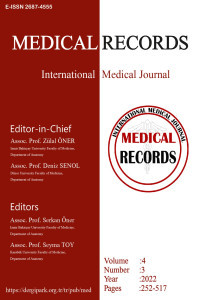Investigation of the Effect of Acute to Chronic Glycemic Ratio on the Development of Postoperative Pneumonia After Stanford Type A Acute Aortic Dissection Surgery
Investigation of the Effect of Acute to Chronic Glycemic Ratio on the Development of Postoperative Pneumonia After Stanford Type A Acute Aortic Dissection Surgery
Type A acute aortic dissection glucose, risk factor, pneumonia,
___
- 1. Engin M, Göncü MT, Güvenç O, et al. Tip A Aort Diseksiyonlarında Operasyon Sonrası Erken Dönem Mortalite ve Morbidite Üzerine Etki Eden Faktörlerin Retrospektif İncelenmesi. Dicle Med Journal. 2018;45:387-96.
- 2. Wei J, Chen Z, Zhang H, et al. In-hospital major adverse outcomes of acute Type A aortic dissection. Eur J Cardiothorac Surg. 2019;55:345-50.
- 3. Gao S, Liu Q, Ding X, et al. Predictive Value of the Acute-to-Chronic Glycemic Ratio for In-Hospital Outcomes in Patients With ST-Segment Elevation Myocardial Infarction Undergoing Percutaneous Coronary Intervention. Angiology. 2020;71:38-47.
- 4. Şimşek B, Çınar T, Ozan V, et al. The association of acute--to—chronic glycemic ratio with no-reflow in patients with ST-segment elevation myocardial infarction undergoing primary percutaneous coronary intervention. Kardiol Pol. 2021;79:170-8.
- 5. Lin L, Lin Y, Peng Y, et al. Admission Hyperglycemia in Acute Type A Aortic Dissection Predicts for a Prolonged Duration of Mechanical Ventilation. Int Heart J. 2022;63:106-12.
- 6. Likosky DS, Harrington SD, Cabrera L, et al. Collaborative Quality Improvement Reduces Postoperative Pneumonia After Isolated Coronary Artery Bypass Grafting Surgery. Circ Cardiovasc Qual Outcomes 2018;11:e004756.
- 7. Elsayed RS, Cohen RG, Fleischman F and Bowdish ME. Acute Type A Aortic Dissection. Cardiol Clin. 2017;35:331-45.
- 8. Eitel I, HintzeS, de Waha S, et al. Prognostic impact of hyperglycemia in nondiabetic and diabetic patients with ST-elevation myocardial infarction: insights from contrast-enhanced magnetic resonance imaging. Circ Cardiovasc Imaging. 2012;5:708–18.
- 9. Worthley MI, Holmes AS, Willoughby SR, et al. The deleterious effects of hyperglycemia on platelet function in diabetic patients with acute coronary syndromes mediation by superoxide production, resolution with intensive insülin administration. J Am Coll Cardiol. 2007;49:304–10.
- 10. Ishihara M, Kagawa E, Inoue I, et al. Impact of admission hyperglycemia and diabetes mellitus on short- and long-term mortality after acute myocardial infarction in the coronary intervention era. Am J Cardiol. 2007;99:1674–79.
- 11. Kewcharoen J, Ali M, Trongtorsak A, et al. Admission hyperglycemia is associated with reperfusion failure in patients with ST-elevation myocardial infarction undergoing primary percutaneous coronary intervention: a systematic review and meta-analysis. Am J Cardiovasc Dis. 2021;11:348-59.
- 12. Anderson BM, Wise BT, Joshi M, et al. Admission Hyperglycemia Is a Risk Factor for Deep Surgical-Site Infection in Orthopaedic Trauma Patients. J Orthop Trauma. 2021;35:e451-e7.
- 13. Sia CH, Chan MH, Zheng H, et al. Optimal glucose, HbA1c, glucose-HbA1c ratio and stress-hyperglycaemia ratio cut-off values for predicting 1-year mortality in diabetic and non-diabetic acute myocardial infarction patients. Cardiovasc Diabetol. 2021;20:211.
- 14. Gao S, Liu Q, Chen H, et al. Predictive value of stress hyperglycemia ratio for the occurrence of acute kidney injury in acute myocardial infarction patients with diabetes. BMC Cardiovasc Disord. 2021;21:157.
- 15. Mondal S, DasGupta R, Lodh M, et al. Stress hyperglycemia ratio, rather than admission blood glucose, predicts in-hospital mortality and adverse outcomes in moderate-to severe COVID-19 patients, irrespective of pre-existing glycemic status. Diabetes Res Clin Pract. 2022;190:109974.
- 16. Chen G, Li M, Wen X, et al. Association Between Stress Hyperglycemia Ratio and In-hospital Outcomes in Elderly Patients With Acute Myocardial Infarction. Front Cardiovasc Med. 2021;8:698725.
- 17. Wang D, Huang X, Wang H, et al. Risk factors for postoperative pneumonia after cardiac surgery: a prediction model. J Thorac Dis. 2021;13:2351-62.
- 18. Wang D, Abuduaini X, Huang X, et al. Development and validation of a risk prediction model for postoperative pneumonia in adult patients undergoing Stanford type A acute aortic dissection surgery: a case control study. J Cardiothorac Surg. 2022;17:22.
- 19. Yao R, Liu X, He Y, et al. Low platelet count is a risk factor of postoperative pneumonia in patients with type A acute aortic dissection. J Thorac Dis. 2020;12:2333-42.
- Yayın Aralığı: Yılda 3 Sayı
- Başlangıç: 2019
- Yayıncı: Zülal ÖNER
Adult Onset Langerhans Cell Histiocytosis: A Single Center Experience
Serhat ÇELİK, Zeynep Tuğba GÜVEN, Onur AŞIK, Muzaffer KEKLİK, Leylagül KAYNAR, Bülent ESER, Mustafa ÇETİN, Ali ÜNAL
Perceived Stress and Hopelessness in COVID-19 Contacts
Mert KARTAL, Muhammet BAYRAKTAR
İrem AKOVA, Mehmet Emin ÖZDEMİR
Effects of Auditory Stimulation and Exercise on Gender Hormones in GMOs-Fed Rats
Ali BOZKURT, Bekir ÇOKSEVİM, Özlem BOZKURT, Işınsu ALKAN, Merve YÜRÜK
Cemil ÇOLAK, Ahmet Kadir ARSLAN, Hasan UCUZAL, Adem KÖSE, İsmail Okan YILDIRIM, Emek GÜLDOĞAN, Mehmet Cengiz ÇOLAK
İsmail ALTIN, Ahmet Sedat DÜNDAR, Erkal GÜMÜŞBOĞA, Mucahit ORUÇ, Osman CELBİŞ, Emine ŞAMDANCI
Orbitofrontal Cortex Volumes in Patients Diagnosed with Somatic Symptom Disorder
Burcu SIRLIER EMİR, Murad ATMACA, Aslı KAZĞAN KILIÇASLAN, Sevler YILDIZ, Hanefi YILDIRIM
Hakan SOYLU, Betül ÜNAL, Kubra AKSU ISTIL, Kayihan KARACOR, Özge BEYAZÇİÇEK, İsmail ÜSTÜNEL
